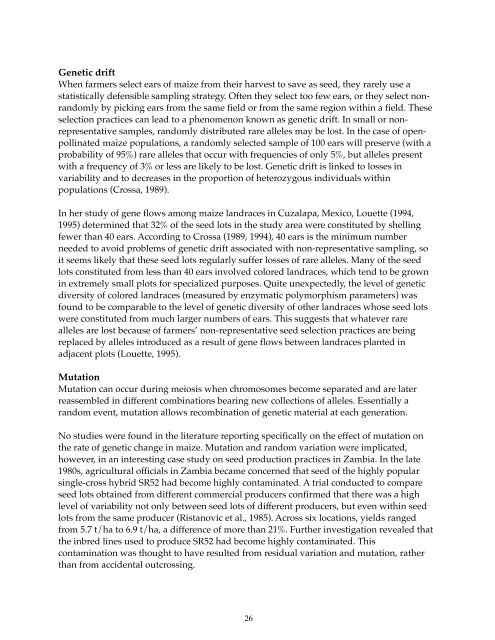A Review of the Evidence - Search CIMMYT repository
A Review of the Evidence - Search CIMMYT repository
A Review of the Evidence - Search CIMMYT repository
Create successful ePaper yourself
Turn your PDF publications into a flip-book with our unique Google optimized e-Paper software.
Genetic driftWhen farmers select ears <strong>of</strong> maize from <strong>the</strong>ir harvest to save as seed, <strong>the</strong>y rarely use astatistically defensible sampling strategy. Often <strong>the</strong>y select too few ears, or <strong>the</strong>y select nonrandomlyby picking ears from <strong>the</strong> same field or from <strong>the</strong> same region within a field. Theseselection practices can lead to a phenomenon known as genetic drift. In small or nonrepresentativesamples, randomly distributed rare alleles may be lost. In <strong>the</strong> case <strong>of</strong> openpollinatedmaize populations, a randomly selected sample <strong>of</strong> 100 ears will preserve (with aprobability <strong>of</strong> 95%) rare alleles that occur with frequencies <strong>of</strong> only 5%, but alleles presentwith a frequency <strong>of</strong> 3% or less are likely to be lost. Genetic drift is linked to losses invariability and to decreases in <strong>the</strong> proportion <strong>of</strong> heterozygous individuals withinpopulations (Crossa, 1989).In her study <strong>of</strong> gene flows among maize landraces in Cuzalapa, Mexico, Louette (1994,1995) determined that 32% <strong>of</strong> <strong>the</strong> seed lots in <strong>the</strong> study area were constituted by shellingfewer than 40 ears. According to Crossa (1989, 1994), 40 ears is <strong>the</strong> minimum numberneeded to avoid problems <strong>of</strong> genetic drift associated with non-representative sampling, soit seems likely that <strong>the</strong>se seed lots regularly suffer losses <strong>of</strong> rare alleles. Many <strong>of</strong> <strong>the</strong> seedlots constituted from less than 40 ears involved colored landraces, which tend to be grownin extremely small plots for specialized purposes. Quite unexpectedly, <strong>the</strong> level <strong>of</strong> geneticdiversity <strong>of</strong> colored landraces (measured by enzymatic polymorphism parameters) wasfound to be comparable to <strong>the</strong> level <strong>of</strong> genetic diversity <strong>of</strong> o<strong>the</strong>r landraces whose seed lotswere constituted from much larger numbers <strong>of</strong> ears. This suggests that whatever rarealleles are lost because <strong>of</strong> farmers’ non-representative seed selection practices are beingreplaced by alleles introduced as a result <strong>of</strong> gene flows between landraces planted inadjacent plots (Louette, 1995).MutationMutation can occur during meiosis when chromosomes become separated and are laterreassembled in different combinations bearing new collections <strong>of</strong> alleles. Essentially arandom event, mutation allows recombination <strong>of</strong> genetic material at each generation.No studies were found in <strong>the</strong> literature reporting specifically on <strong>the</strong> effect <strong>of</strong> mutation on<strong>the</strong> rate <strong>of</strong> genetic change in maize. Mutation and random variation were implicated,however, in an interesting case study on seed production practices in Zambia. In <strong>the</strong> late1980s, agricultural <strong>of</strong>ficials in Zambia became concerned that seed <strong>of</strong> <strong>the</strong> highly popularsingle-cross hybrid SR52 had become highly contaminated. A trial conducted to compareseed lots obtained from different commercial producers confirmed that <strong>the</strong>re was a highlevel <strong>of</strong> variability not only between seed lots <strong>of</strong> different producers, but even within seedlots from <strong>the</strong> same producer (Ristanovic et al., 1985). Across six locations, yields rangedfrom 5.7 t/ha to 6.9 t/ha, a difference <strong>of</strong> more than 21%. Fur<strong>the</strong>r investigation revealed that<strong>the</strong> inbred lines used to produce SR52 had become highly contaminated. Thiscontamination was thought to have resulted from residual variation and mutation, ra<strong>the</strong>rthan from accidental outcrossing.26
















